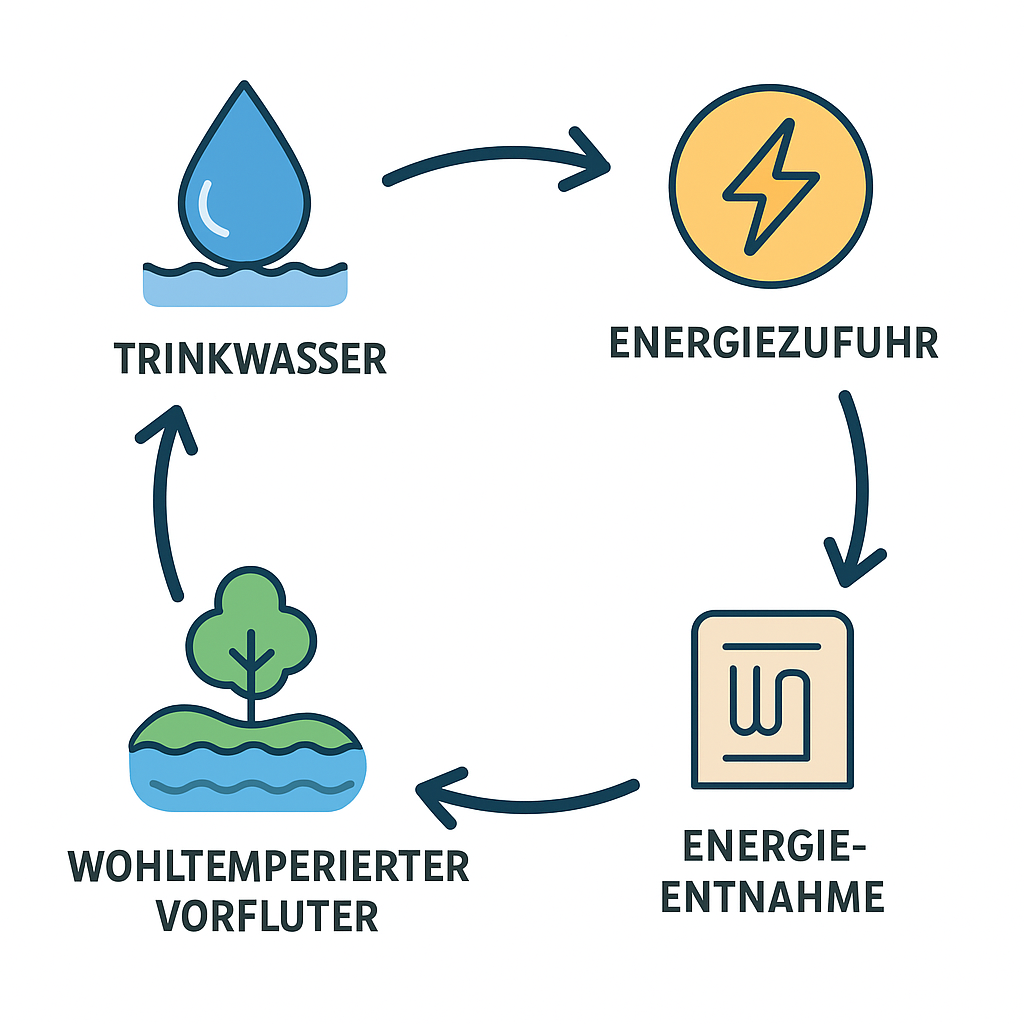Topic: How we bring cold back into nature!
Subject area: ENERGY, TEXTILES, ELECTRICAL ENGINEERING, MEDIA (ETEM)
Subject areas: Wastewater, energy, and water
1. Purpose
Systematic recovery of waste heat and environmental heat from water and air systems to relieve rivers and ecosystems, combined with energy savings, CO₂ reduction, and sustainable circular economy (phosphorus recovery, rehardening). The aim is for readers to learn the content according to the DGUV scheme and for political decision-makers and environmental organizations to be motivated to actively demand measures.
2. Scope of application
All municipal and industrial wastewater treatment plants and drinking water works in Germany and the EU, especially those with digester gas production, wastewater heating, and peak electricity demand.
3. Terms
Heat pump (HP): Device for using ambient heat or wastewater heat for heating or cooling. Digester gas: Methane-containing gas from anaerobic digestion in wastewater treatment plants. Hardening or re-hardening: Increasing the carbonate hardness of softened water by adding calcium carbonate. Phosphorus recovery: Recovery of plant-available phosphate from wastewater.
4. Responsibility
Municipal waterworks, wastewater associations, energy suppliers, environmental agencies. Participation of environmental organizations and political decision-makers (Green Party, local politics). Technical management: sewage treatment plant operation, drinking water plant management.
5. Description / Measures
Heat pumps in sewage treatment plants: Use of treated wastewater as a heat source. Operation of heat pumps primarily during periods of excess electricity to cool wastewater and relieve pressure on rivers. Thanks to heat pumps, gas is unlikely to be required even in winter. Integration into local heating networks and municipal energy systems.
Phosphorus recovery: Lime process for plant-available phosphates, connection to heat recovery and CO₂ reduction.
Rehardening in drinking water: CaCO₃ reactor grain from rapid decarbonization in clarification ponds or aeration, increasing buffer capacity.
Municipal & political involvement: GREENS, environmental organizations, municipalities, water associations, UBA inform and motivate mandatory testing.
Communication & campaign: Slogan “This is how we bring cold back to nature!”, flyers, short videos, school and university cooperation.
6. Applicable documents
Technical data sheets for heat pumps, storage tanks, and reactor grains. Measurement reports, pilot tests, monitoring concepts. Legal requirements (Drinking Water Ordinance, Water Framework Directive, municipal regulations).
7. Documentation
Pilot tests in the clarification pond, dosing reports for re-hardening, temperature and level recordings, gas and energy consumption. Phosphorus recovery: chemical analyses, material flow documentation.
8. Management
Define responsible bodies: technical management, monitoring, municipal coordination. Regular reports to associations, environmental organizations, and politicians. Adjust measures based on monitoring results.
9. Systems / Visualization
Flowcharts of wastewater and heat flows. Pilot images from clarification ponds, heat pump systems, reactor cores. Graphical representation of the cold recovery cycle.
Key statement for brainstorming
Heat recovery is climate protection: when sewage treatment plants and waterworks store heat and return cold, environmental protection begins where energy was previously lost.
Translated with DeepL.com (free version)
WASTEWATER TREATMENT PLANTS
Theme: Bringing the Cold Back to Nature!
Sector: ENERGY, TEXTILES, ELECTRICAL, MEDIA (ETEM)
Subjects: Wastewater, Energy, and Water
1. Purpose
Systematic recovery of waste heat and environmental heat from water and air systems to relieve rivers and ecosystems, combined with energy savings, CO₂ reduction, and sustainable circular economy practices (phosphorus recovery, water re-hardening).
The goal is for readers to learn the content following the DGUV framework and for political decision-makers and environmental organizations to be motivated to actively demand action.
2. Scope
All municipal and industrial wastewater treatment plants and drinking water facilities in Germany and the EU, particularly those with digester gas production, wastewater heating, and peak electricity demand.
3. Definitions
- Heat pump (HP): Device that uses ambient or wastewater heat for heating or cooling.
- Digester gas: Methane-containing gas from anaerobic digestion in wastewater treatment plants.
- Re-hardening: Increasing the carbonate hardness of softened water by adding calcium carbonate.
- Phosphorus recovery: Extraction of plant-available phosphate from wastewater.
4. Responsibilities
- Municipal water utilities, wastewater associations, energy suppliers, environmental agencies.
- Involvement of environmental organizations and political stakeholders (e.g., Green Party, local governments).
- Technical management: wastewater treatment operations, drinking water plant management.
5. Description / Measures
Heat pumps in wastewater treatment plants:
- Use of treated wastewater as a heat source.
- Operate HPs primarily during electricity surpluses to cool wastewater and relieve rivers.
- With HPs, gas use is likely unnecessary even in winter.
- Integration into district heating networks and municipal energy systems.
Phosphorus recovery:
- Lime-based processes for producing plant-available phosphates, linked to heat recovery and CO₂ reduction.
Re-hardening in drinking water treatment:
- Use of CaCO₃ reactor granules from rapid decarbonization in polishing ponds or aeration tanks to increase buffer capacity.
Municipal & political integration:
- Inform and motivate Green Party representatives, environmental organizations, municipalities, water associations, and the German Environment Agency (UBA) to conduct mandatory feasibility reviews.
Communication & campaign:
- Slogan: “Bringing the Cold Back to Nature!”
- Flyers, short videos, collaborations with schools and universities.
6. Applicable Documents
- Technical datasheets for heat pumps, storage units, and reactor granules.
- Measurement protocols, pilot studies, monitoring concepts.
- Legal requirements (Drinking Water Ordinance, Water Framework Directive, municipal regulations).
7. Documentation
- Pilot trials in polishing ponds, dosing protocols for re-hardening, temperature and water level recordings, gas and energy consumption logs.
- Phosphorus recovery: chemical analyses, material flow documentation.
8. Control
- Define responsible entities: technical management, monitoring, municipal coordination.
- Regular reporting to associations, environmental organizations, and policymakers.
- Adaptation of measures based on monitoring results.
9. Attachments / Visualization
- Flow diagrams of wastewater and heat streams.
- Pilot images from polishing ponds, HP installations, and reactor granules.
- Graphic representation of the cold recovery cycle.
Core Statement for Brainstorming
Heat recovery is climate protection:
When wastewater treatment and water facilities store heat and return cold to nature, environmental protection begins exactly where energy used to be lost.

| Revision: 1 | Erstellt/Geändert: | Geprüft: | Freigegeben: | Gültig ab: |
| Datum: | 30.10.2025 | 30.10.2025 | 30.10.2025 | 30.10.2025 |
| Unterschrift: | Beauftragter | Aufsichtsrat | Vorstand | Beauftragter |